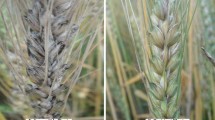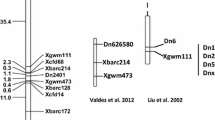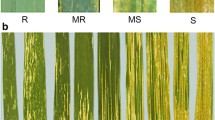Abstract
Identification of new sources of resistance to Russian wheat aphid (RWA) (Diuraphis noxia (Kurdjumov) in wheat (Triticum aestivum L.) has become very important with the identification of several new biotypes since 2003. Our objective was to characterize inheritance and expression of resistance to RWA biotype 2 from three tetraploid wheat landraces (Triticum turgidum L. subsp. dicoccon) during transfer to hexaploid wheat. Resistant tetraploid accessions PI 624903, PI 624904, and PI 624908 were crossed to the susceptible hexaploid cultivars ‘Len’ and ‘Coteau’. Resistant F1 progeny were advanced to the F2:3 by self-pollination and to the BC1F2 and BC2F1 by backcrossing. Leaf rolling and chlorosis were recorded in standard seedling screening tests on F1 and F2:3 individuals while the F2, BC1F1, BC1F2, and BC2F1 were scored as resistant or susceptible. Segregation in the BC1F1 and BC2F1 fit a 1:1 resistant:susceptible ratio, indicative of control by a single dominant gene. Segregation for resistance in the F2 did not fit 3:1, 13:3, or 15:1 ratios for any of the resistant accessions. Expression of resistance in homogeneous resistant F2:3 lines was greater than susceptible checks, similar to the resistant tetraploid accessions, and less than a line carrying the Dn7 resistance gene. Resistance derived from these tetraploid accessions will be useful to broaden the base of RWA resistance available for use in wheat breeding.
Similar content being viewed by others
References
Anderson GR, Papa D, Peng JH, Tahir M, Lapitan NLV (2003) Genetic mapping of Dn7, a rye gene conferring resistance to the Russian wheat aphid in wheat. Theor Appl Genet 107:1297–1303
Basky Z (2003) Biotypic and pest status differences between Hungarian and South African populations of Russian wheat aphid, Diuraphis noxia (Kurdjumov) (Homoptera:Aphididae). Pest Manag Sci 59:1152–1158
Berzonsky WA, Ding H, Haley SD, Harris MO, Lamb RJ, McKenzie RIH, Ohm HW, Patterson FL, Peairs FB, Porter DR, Ratcliffe RH, Shanower TG (2002) Breeding wheat for resistance to insects. Plant Breed Rev 22:221–296
Burd JD, Porter DR, Puterka GJ, Haley SD, Peairs FB (2006) Biotypic variation among North American Russian wheat aphid (Homoptera: Aphididae) populations. J Econ Entomol 99:1862–1866
Collins MB, Haley SD, Peairs FB, Rudolph JB (2005) Russian wheat aphid Biotype 2 resistance among wheat germplasm accessions. Crop Sci 45:1877–1880
Elsidaig AA, Zwer PK (1993) Genes for resistance to Russian wheat aphid in PI 294994. Crop Sci 33:998–1001
Grama A, Gerechter-Amitai ZK (1974) Inheritance of resistance to stripe rust (Puccinia striiformis) in crosses between wild emmer (Triticum dicoccoides) and cultivated tetraploid and hexaploid wheats. II. Triticum aestivum. Euphytica 23:393–398
Graybosch RA, Peterson CJ, Hansen LW, Mattern PJ (1990) Relationships between protein solubility characteristics, 1BL/1RS, high molecular weight glutenin composition, and end-use quality in winter wheat germplasm. Cereal Chem 67:342–349
Guyomarc’h H, Sourdille P, Edwards KJ, Bernard M (2002) Studies of the transferability of microsatellites derived from Triticum tauschii to hexaploid wheat and to diploid related species using amplification, hybridization and sequence comparisons. Theor Appl Genet 105:736–744
Haley SD, Peairs FB, Walker CB, Rudolph JB, Randolph TL (2004) Occurrence of a new Russian wheat aphid biotype in Colorado. Crop Sci 44:1589–1592
Kushnir U, Halloran GM (1984) Transfer of high kernel weight and high protein from wild tetraploid wheat (Triticum turgidum dicoccoides) to bread wheat (Triticum aestivum) using homologous and homoeologous recombination. Euphytica 33:249–255
Liu XM, Smith CM, Gill BS, Tolmay V (2001) Microsatellite markers linked to six Russian wheat aphid resistance genes in wheat. Theor Appl Genet 102:504–510
Marais GF, Horn M, Du Toit F (1994) Intergeneric transfer (rye to wheat) of a gene(s) for Russian wheat aphid resistance. Plant Breed 113:265–271
Marais GF, Pretorius ZA, Marais AS, Wellings CR (2003) Transfer of rust resistance genes from Triticum species to common wheat. S Afr J Plant Soil 20:193–198
Mesfin A, Frohberg RC, Anderson JA (1999) RFLP markers associated with high grain protein from Triticum turgidum L. var dicoccoides introgressed into hard red spring wheat. Crop Sci 39:508–513
Mesfin A, Frohberg RC, Khan K, Olson TC (2000) Increased grain protein content and its association with agronomic and end-use quality in two hard red spring wheat populations derived from Triticum turgidum L. var dicoccoides. Euphytica 116:237–242
Morrison WP, Peairs FB (1998) Response model concept and economic impact. In: Quisenberry SS, Peairs FB (eds) Response model for an introduced pest-The Russian Wheat Aphid. Thomas Say Publications, Lanham, pp 1–11
Nevo E (2001) Genetic resources of wild emmer, Triticum dicoccoides, for wheat improvement in the third millennium. Isr J Plant Sci 49:S77–S91
Nkongolo KK, Quick JS, Meyer WL, Peairs FB (1989) Russian wheat aphid resistance of wheat, rye, and Triticale in greenhouse tests. Cereal Res Commun 17:227–232
Porter DR, Baker CA, El-Bouhssini M (2005) Resistance in wheat to a new North American-Russian wheat aphid biotype. Plant Breed 124:603–604
Puterka GJ, Burd JD, Burton RL (1992) Biotypic variation in a worldwide collection of Russian wheat aphid (Homoptera, Aphididae). J Econ Entomol 85:1497–1506
Reader SM, Miller TE (1991) The Introduction into bread wheat of a major gene for resistance to powdery mildew from wild emmer wheat. Euphytica 53:57–60
SAS Institute (1999) SAS/STAT user’s guide. SAS Institute, Cary
Smith CM, Belay T, Stauffer C, Stary P, Kubeckova I, Starkey S (2004) Identification of Russian wheat aphid (Homoptera: Aphididae) populations virulent to the Dn4 resistance gene. J Econ Entomol 97:1112–1117
Souza EJ (1998) Host plant resistance to the Russian wheat aphid (Homoptera: Aphididae) in wheat and barley. In: Quisenberry SS, Peairs FB (eds) Response model for an introduced pest-The Russian Wheat Aphid. Thomas Say Publications, Lanham, pp 122–147
Stoetzel MB (1987) Information on and identification of Diuraphis noxia (Homoptera, Aphididae) and other aphid species colonizing leaves of wheat and barley in the United-states. J Econ Entomol 80:696–704
USDA-Agricultural Research Service (2008) National plant germplasm system. USDA-ARS, Washington, DC. http://www.ars-grin.gov/npgs/index.html. Accessed 19 March 2010
Webster JA, Starks KJ, Burton RL (1987) Plant-Resistance Studies with Diuraphis-Noxia (Homoptera, Aphididae), a New United-States Wheat Pest. J Econ Entomol 80:944–949
Weiland AA, Peairs FB, Randolph TL, Rudolph JB, Haley SD, Puterka GJ (2008) Biotypic diversity in Colorado Russian wheat aphid (Hemiptera: Aphididae) populations. J Econ Entomol 101:569–574
Zhang Y, Quick JS, Liu S (1998) Genetic variation in PI 294994 wheat for resistance to Russian wheat aphid. Crop Sci 38:527–530
Acknowledgments
Appreciation is extended to John Stromberger, Jeff Rudolph, Scott Reid, and Emily Heaton for assistance with handling greenhouse material, screening and scoring material, and DNA marker and cytogenetic analyses. Research supported in part by the Colorado Wheat Administrative Committee, the Colorado Wheat Research Foundation, and USDA-CSREES Special Research Grants Nos. 2003-34205-13636 and 2006-34205-17358, and the National Research Initiative of USDA’s Cooperative State Research, Education and Extension Service CAP Grant No. 2006-55606-16629.
Author information
Authors and Affiliations
Corresponding author
Rights and permissions
About this article
Cite this article
Beyer, B.M., Haley, S.D., Lapitan, N.L.V. et al. Inheritance of Russian wheat aphid resistance from tetraploid wheat accessions during transfer to hexaploid wheat. Euphytica 179, 247–255 (2011). https://doi.org/10.1007/s10681-010-0299-4
Received:
Accepted:
Published:
Issue Date:
DOI: https://doi.org/10.1007/s10681-010-0299-4




